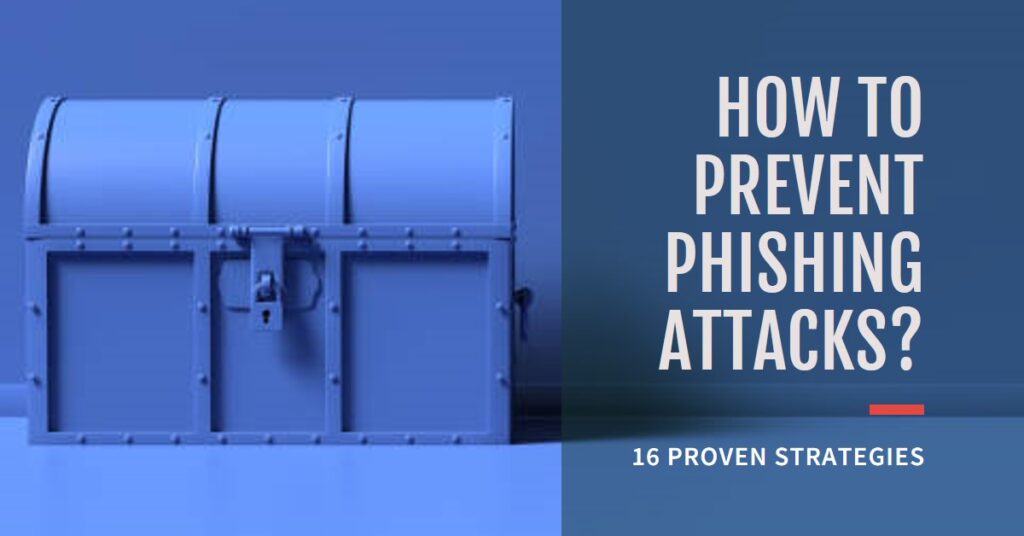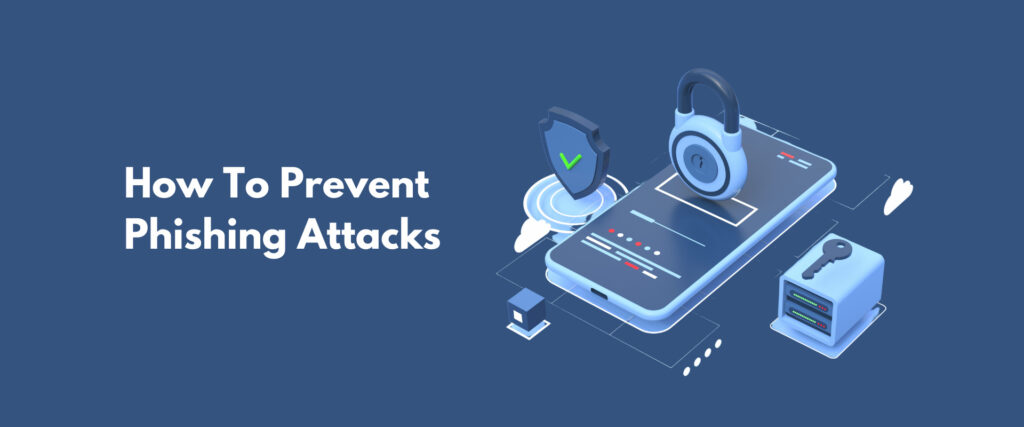How To Prevent Phishing Attacks? – 15 Proven Strategies

Phishing attacks are one of the most common forms of cyberattacks today, and they are a serious threat to businesses and individuals alike. It is now more important than ever to learn how to prevent phishing attacks in its tracks. These attacks involve tricking victims into revealing sensitive information such as passwords, credit card details, or other personal or business information. With time, Phishing attacks are getting more and more sophisticated.
In the context on businesses and organisations, phishing attacks are designed to exploit the human risk (human vulnerability) where attackers execute phishing attacks on employees of an organisation in order to gain access to sensitive information, financial data, or customer data.
In this blog post, we will share 15 expert-recommended strategies to prevent phishing attacks.
Why Prevent Phishing Attacks?
As per CISCO’s Cybersecurity Threat Trends report, almost 90% of data breaches in organisations worldwide occur due to phishing attacks. Spear phishing is the most common type of phishing attack and it comprises 65% of all attacks. Another research from IronScales quotes that 81% of organisations around the world have seen an uptick in email phishing attacks since March 2020. And a study by APWG observed highest number of phishing attacks in Q3 2022.
According to the 2023 Global Threat Report by Crowdstrike:
- 33 newly named adversaries in 2022
- 200+ adversaries targeting organizations across the globe
- 71% of attacks in 2022 were malware-free
- 95% increase in cloud exploitation
- 112% increase in access broker advertisements on the dark web
- 84-minute average eCrime breakout time
The aftermath of phishing attacks leaves organisations with huge losses, shattered public image, and months of work to reclaim and grow out of the attacks. That’s why at TIKAJ our no. 1 goal is to keep our clients updated with the latest developments in the cybersecurity space and keep them armed with the latest information on how to prevent phishing attacks. Phishing attack prevention is the step 1 for an organisation’s cybersecurity strategy.
15 Strategies & Tips On How To Prevent Phishing Attacks

These 15 strategies are curated keeping in mind that an organisation of any size can implement these on their own. We encourage organisations to regularly share latest information and proven best practices on how to prevent phishing attacks with their employees. Since employees are the biggest risk surface for any organisation and human vulnerability (human risk) is the biggest cause of successful phishing attacks around the world.
1. Use Anti-Phishing Services
Anti-phishing services can be effective in preventing phishing attacks. These tools are designed to detect and block phishing emails, websites, and other suspicious activities. They can help you to identify and avoid potential phishing attacks before they can do any damage. Anti-phishing tools identify phishing attacks in their tracks using several methods like phishing feed, referrer logs, etc.
2. Use Two-Factor Authentication
Two-factor authentication adds an extra layer of security to your accounts by requiring a second factor, such as a code sent to your phone, in addition to your password. There are many 2FA apps available for free in the market such are Google Authenticator, Microsoft Authenticator, Authy, Twilio, etc. This makes it much harder for attackers to gain access to your accounts, even if they have your password. Encourage employees across your organisation to use 2FA as basic step in prevent fraudulent access and to prevent phishing attacks.
3. Be Suspicious of Email Attachments and Links
Phishing emails often contain attachments or links that are designed to download malware or direct you to a fraudulent website or URL. Be suspicious of any email attachments or links that you weren’t expecting, and always verify the authenticity of the email before clicking on anything. As the email phishing attacks get more and more sophisticated it is difficult for employees to identify and detect a threat. We recommend that organisations run company wide phishing attack simulations regularly, which are contextual, and educate employees about the potential consequences.
4. Verify Authenticity of Emails / Use Email Filters
One of the most effective ways to prevent phishing attacks is to verify the authenticity of emails before taking any action. Check the email address and the content of the email carefully to make sure that it is from a legitimate source. Also, most email client apps offer filters that can automatically detect and block suspicious emails. Use these filters to reduce the number of phishing emails that make it into your inbox. Here are 5 tips to mitigate the email impersonation risk.
5. Have a Data Security Platform to spot signs of an attack
Having a data security platform to detect signs of an attack is an essential component of any organisation’s cybersecurity strategy. You can explore many such cybersecurity solutions that cover network security, vulnerability assessment, etc.
6. Check for HTTPS in Website Addresses
Before entering any sensitive information into a website, make sure that the URL starts with “https”. This indicates that the website is using a secure connection and is less likely to be a phishing site.
7. Use Strong & Unique Passwords (Rotate passwords regularly)
Using strong and unique passwords for all your accounts can help to prevent phishing attacks. Avoid using the same password across multiple accounts, and use a password manager to generate and store strong passwords securely. Rotating your passwords is something that can be easily done on a personal level on how to prevent phishing attacks.
8. Keep Software Up to Date
Make sure that all the software on your devices is up to date, including your operating system, web browser, and anti-virus software. Keeping software up to date can help to protect against known security vulnerabilities. Usually attackers exploit loopholes and vulnerability in older softwares that get improved and fixed in the newer versions. That is why it is recommended to keep your softwares up to date to prevent phishing attacks.
9. Know What Phishing Attacks & Scams Looks Like
Being aware of the latest phishing tactics and techniques can help you to identify and avoid potential attacks. Stay up to date with the latest phishing news and best practices, and educate yourself about how to protect against phishing attacks. Phishing simulation platforms can help employees in your organisations to know what scams and phishing attacks look like.
10. Install Firewalls
Firewalls are essential components of any organisation’s cybersecurity strategy. They are designed to protect your network from unauthorised access, malware, and other types of cyber threats.
11. Be Careful on Social Media & Don’t Give Important Information
Attackers can use social media to gather information about you, which they can use to launch phishing attacks. Be careful what you post on social media, and avoid clicking on links received from people you don’t know or you find suspicious. Determine the type of firewall that suits your organization’s needs. There are two types of firewalls: hardware and software-based. Some popular firewall solutions include Cisco ASA, Fortinet, and Palo Alto Networks.
12. Don’t Trust Caller ID
Attackers can use spoofing to make it look like they are calling from a legitimate number. Always verify the authenticity of callers before sharing any sensitive information. Also note that attackers create urgency and ask for information over the calls to execute the attacks.
13. Monitor Your Accounts
Keep a close eye on your bank and credit card statements for any suspicious activity. Report any unauthorized transactions immediately to prevent further damage. This is also true for organisations and accounting teams to monitor fees and deductions on cards and accounts.
14. Avoid Public Wi-Fi
Public Wi-Fi networks can be insecure and make it easier for attackers to intercept your data. Avoid using public Wi-Fi networks, or use a virtual private network (VPN) to encrypt your data and protect against potential attacks.
15. Don’t give your information to an unsecured site
Be cautious about sharing personal information online, and only provide it to trusted sources. Limit the amount of personal information that you share, and avoid providing sensitive information such
How Tikaj Helps in Preventing Phishing Attacks
If you are looking for services and solutions to prevent phishing attacks and strengthen your organisations cyber security, you can explore solutions and services by Tikaj. If you want to learn more about how to prevent phishing attacks, you can schedule a call for free cybersecurity consultation by Tikaj. Tikaj offers cybersecurity compliance, solutions to identify vulnerability, offers tools to protect digital identify, and also offers personalised consulting to elevate your organization’s protection and security.
FAQs
What is phishing attack?
Phishing is a type of cyber attack in which an attacker, posing as a legitimate entity, tries to trick someone into divulging sensitive information such as login credentials, credit card numbers, or personal or organisational information. Learn about u003ca href=u0022https://www.tikaj.com/blog/10-types-of-phishing-attacks/u0022 data-type=u0022URLu0022 data-id=u0022https://www.tikaj.com/blog/10-types-of-phishing-attacks/u0022 target=u0022_blanku0022 rel=u0022noreferrer noopeneru0022u003eTypes of phishing attacksu003c/au003e here.
How can phishing be prevented? (how to prevent spam and phishing)
There are a few measure that organisation and employees can learn about on How to prevent phishing attacks. Some of those are:u003cbru003e1. Use Anti-Phishing Servicesu003cbru003e2. Use Two-Factor Authenticationu003cbru003e3. Be Suspicious of Email Attachments and Linksu003cbru003e4. Verify Authenticity of Emails / Use Email Filtersu003cbru003e5. Have a Data Security Platform to spot signs of an attack
What is the main cause of phishing attacks?
If you understand the main cause of cyber attacks, it gets easier to know how to prevent phishing attacks. The main cause of phishing attacks is the desire of cybercriminals to obtain sensitive information for financial gain or other malicious purposes. Phishing attacks are often carried out by individuals or groups who are seeking to steal login credentials, credit card numbers, or other personal information that can be used for identity theft, fraud, or other criminal activities.
How to identify u0026amp; avoid phishing attacks?
Companies and employees within organisations do communicate via email, but legitimate email or text would never ask for your payment information or send links to share data. Phishing emails often have real consequences for people who give attackers their information, including identity theft.u003cbru003eu003cbru003eu003cstrongu003e4 Ways to avoid phishing attacks:u003c/strongu003eu003cbru003e1. Protect your computer by using security software.u003cbru003e2. Protect your cell phone by setting software to update automaticallyu003cbru003e3. Protect your accounts by using two-factor authenticationu003cbru003e4. Protect your data by taking its backup
Conclusion
These are the 15 ways on how to prevent phishing attacks are some of the many strategies that organisations and individuals can rely on. For organisations that deal with sensitive data of users, crucial financial data, and large employee base must consult with cybersecurity providers to form a comprehensive cybersecurity strategy.






